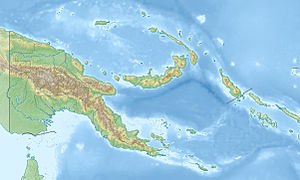Parama Island
| Parama Island (Bampton Island) |
||
|---|---|---|
|
Landsat image from Parama Island (note: under the clouds!) |
||
| Waters | Pacific Ocean | |
| Archipelago | Torres Strait Islands | |
| Geographical location | 9 ° 0 ′ 9 ″ S , 143 ° 24 ′ 55 ″ E | |
|
|
||
| length | 9.6 km | |
| width | 5.7 km | |
| surface | 36.8 km² | |
| Highest elevation | 3 m | |
| Residents | 441 (2000) 12 inhabitants / km² |
|
| main place | Parama Village | |
| NASA satellite image (Geocover 2000) | ||
Parama Island (formerly Bampton Island ) is an island near the south coast of Papua New Guinea . It is located 17 km east of Daru Island , on which the provincial capital of the Western Province is located, at the southern end of the Fly River Delta, and is also considered the northernmost of the Torres Strait Islands . Bampton Point, the southern cape of the island, marks the southwest corner of the Gulf of Papua . The Coral Sea is in the southeast. The Torres Strait is in the south and southwest, specifically the Great Northeast Channel , which separates Parama Island from the nearest Australian ( Queensland ) island (and thus also from the Great Barrier Reef ), namely from Bramble Cay , 48 km east-southeast.
Parama has an approximately rectangular shape, is 9.6 km long and up to 5.7 km wide, with a circumference of 27.7 km and an area of 37 km². The island is low, flat and overgrown with mangroves . It is separated from the main island of New Guinea by the Toro Passage, which is 400 to 700 meters wide, seven kilometers long, and 1.8 to 5.5 meters deep.
Administratively, the island belongs to the Kwai Rural LLG (Local Level Government area) of the South Fly District in the Western Province .
The total population of 441 (2000 census) lives in the village of Parama on the east coast of the Gulf of Papua. For 1991 a population of 240 was given. Only a small area around the village is used for agriculture. The village consists of six clan districts. The clans, which also bear names of animals, from north to south (1991):
- Doriomu (Shark, formerly Tebere) (the school is west of the clan district)
- Maruadai (Marowadai) (Cassowary) (with the United Church )
- Hegeredai (Dingo)
- Oromorubi (Dog)
- Miaridai (Crocodile) (with the hospital)
- Gaidai (Eagle)
A more recent list (1995) shows only five clans, replacing Hegeredai and Oromorubi with Sobogu .
The list of five clans in a dissertation also dates from 1995, each with an indication of the households per clan (58 households in total):
- Doriomo (7)
- Marawadai (13)
- Oromorubi (12)
- Mearidai (20)
- Gaidai (6)
Originally there was talk of three villages Bugido , Tetebe and Auo Mouro .
In the southwest of the island is Gaziro (Gasiri), a temporary fishing camp that is also used by the population of the main island.
The fringing reef on the east coast in front of the village, the home reef , is known locally as Podomaza .
Worimo Reef, a desiccant rock and sand reef that breaks waves during southeast winds, is eight kilometers southeast of Bampton Point. It extends further to the Merrie England Shoals, with depths of less than two meters.
Ellengowan Rock, a submarine rock with a water depth of only 1.1 meters, is located 11 kilometers east of Parama Island.
Web links
- Pub. 164, New Guinea, Sector 6, South Coast of Papua New Guinea-Bensbach River to South Cape, National Imagery and Mapping Agency, 2003 (PDF file; 480 kB)
- The Geography of Border Landscapes in Google Book Search, ed. Dennis Rumley and Julian V. Minghi, Routledge, 1991, ISBN 0-415-04825-7
- Lower Fly Area Study, 1995 (PDF file; 1.84 MB)
- Torres Strait Atlas
Individual evidence
- ↑ Papua New Guinea WWWVL in Maps ( Memento from June 9, 2007 in the Internet Archive )
- ^ Donald M. Schug: The Marine Realm and a Sense of Place Among the Papua New Guinean Communities of the Torres Strait , p. 246
- ^ Alfred C. Haddon: Reports of the Cambridge Anthropological Expedition to Torres Straits. Vol. 1 General Ethnography (1935) , p. 237


